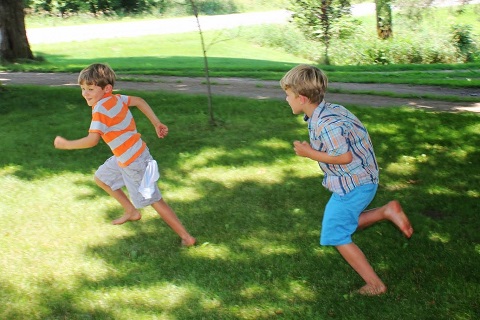Adapt the game, change the outcome

In this third instalment on warm-up games we’re taking a slightly different approach. Instead of giving you a list of games and descriptions, in this article, we’re going to look at how to change or modify a basic warm-up game to achieve different learning outcomes.
First of all, let’s look at what makes a good warm-up game. A good warm-up game covers the 4F’s (term borrowed from Gymnastics Australia) - Fun, Fitness, Friendship, Fundamentals and Safety.
- Fun - The students should enjoy playing the game
- Fitness - A good warm-up game should result in the students lightly perspiring. You can’t get warm if you’re sitting out.
- Friendship - Games should encourage students to work together, preferably across friendship groups.
- Fundamentals - What is the learning outcome of the game? I like my warm-up games to have something to do with the upcoming session, or to revise something from the previous session.
- Safety - Be mindful of the level of the participants, and the area you are working in. Young children tend to have tunnel vision and think only about themselves. They are not very good a looking around them and watching where they are going. Unless the game is specifically designed for it, I tend to avoid letting kids run, and prefer skipping for most games. It’ll slow them down, still warm them up, and decrease the risk of them running into someone.
Probably the best way to do this is to look at a very basic warm-up game, and then examine what changes we can make to it to change the dynamics and learning outcomes.

We’ll start with a basic game of Scarecrow Tiggy. Choose 4 taggers. It’s the taggers job to try and get everybody stuck. When a tagger gets you, you stand in a star shape. You stay stuck there until someone crawls under your legs. They must crawl under you. Taggers can’t get you while your crawling under someone, and they can’t stand there waiting for you either.
It’s an oldie, but a goodie. You’d be hard pressed to find kids who don’t know basic scarecrow tiggy. Now, let’s make some changes.
-
The number of taggers.
You can increase or decrease the number of taggers to make the game easier or harder for both teams, you can increase or decrease depending on the class size. If you have an older group and your goal is team work, why not try the game with 50 / 50 taggers / non-taggers? If the non-taggers are good at working together to free each other, then they should never all get stuck. If the majority of the groups thinking is “I need to get away from the tagger fast”, then they will likely all get stuck; but if their thinking is more about “I need to save Freddy” then it is much more likely that the taggers will not be able to win.
-
The playing area.
By decreasing or increasing the size of the playing area you can change the difficulty level of the game. I find that a smaller playing area is more fun than a larger playing area. If you spend all your time wandering around in the field with no need to run, then you’re not really hitting 2 of the 4F’s – Fun & Fitness.
-
Restrictions.
You can really hone in on the Friendship element by placing restrictions on the taggers / non-tagger. For example, perhaps the girl taggers can only tag boys, and vice-versa. Perhaps you can only free someone of the opposite gender. Maybe you could introduce 4 teams – yellow, blue, red, and green. Everyone can tag, everyone can save. But you can only tag people from a different team.
-
The shape you make.
It doesn’t have to be a star shape that you make when you are tagged. Try is with a Front Support (this variation is also known as ‘stuck in the mud’) instead. Or maybe each tagger, instead of saying ‘tag’, says a different shape. The person gets stuck in that shape when they’re tagged. You could have a Front Support tagger, a Back Support tagger, and a Side Support tagger – they say ‘Front’, ‘Back’ and ‘Side’ respectively when tagging.
It doesn’t have to be a shape on the ground either. You could just as easily say - “when the tagger gets you you have to balance on one foot, with your arms out to the side. You get free by two people coming up and clapping your outstretched hands - one person on each side - but they can’t save you unless you are perfectly still.
-
How you get free.
Instead of someone having to crawl under you, you could change it so that the when tagged you have to perform a certain action - such as “do 10 star jumps”. Or if you want to make it more of a partner activity, then if you are tagged then your partner has to do the action to set you free again.
-
The form of Locomotion.
Change it up a bit, instead of skipping or running, why not try jumping, bear walking, side stepping, etc… Or, if you want a more team oriented game – make them hold hands with one or more people, if either gets tagged, they both get stuck.
That’s enough for this article, but you can see how you can make some very basic tweaks that completely change what the learning outcomes are. Just keep in mind the 4F’s - Fun, Fitness, Friendship, Fundamentals and Safety.
Why not check out some of our other blogs on warm-up games for some different game ideas:

